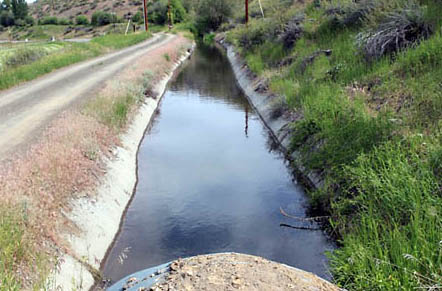home | internet service | web design | business directory | bulletin board | advertise | events calendar | contact | weather | cams

|
Tale of Two Ditches  The Barkley ditch above East County Road. The Barkley ditch above East County Road.The Methow Valley Irrigation District’s water delivery improvement project has run into a snag that threatens to leave the system’s east side irrigators without a way to get their water delivered. The $10 million project is funded by taxpayers and Bonneville Power Administration ratepayers. For more than 90 years, the irrigation district (MVID) has shared two miles of open canal with the Barkley Irrigation Co. The MVID uses that stretch of the Barkley ditch--near the old Vander Yacht dairy and Mill Hill on the east side of East County Road--to deliver water to irrigate about 400 acres for members on the east side of the valley, according to MVID secretary Bunny Morgan. The Barkley ditch, like the MVID before it, has been told by state and federal agencies that it must modernize its water delivery system. So Barkley ditch directors are preparing to pipe their six-mile long system, which irrigates about 600 acres, according to Aaron Penvose, Trout Unlimited’s project manager for the Barkley ditch upgrade. But the Barkley pipe will not be big enough to carry the MVID’s share of the water, said Greg Knott, Trout Unlimited’s project manager for the MVID system upgrade. This means the MVID cannot use the Barkley pipe to move its water to members. Penvose told Methow Grist the Barkley piping project will not affect the amount of water going to MVID members. “Everybody will get their water,” he said. “The two entities are working to find a solution,” he added. “We are trying to keep the MVID directors in the loop.”  MVID members and directors discuss ditch modernization plans. MVID members and directors discuss ditch modernization plans.At the time MVID officials applied for funds to turn their gravity operated system into a pump and pipe operation, they did not know the Barkley ditch would be putting in a pipe, Knott told Methow Grist. The MVID does not have the $1 million needed to put in a pipe of its own along the same stretch of canal, he said, adding: “If we don’t have money to pipe our water, what’s going to happen to MVID’s water?” Meanwhile, due to high costs the MVID has abandoned its plan to use one well to supply and pump water uphill from the Dave Schultz orchard behind Hank’s supermarket in Twisp to a 35-foot high storage tank on Bill White’s property above town, said Knott. Instead, four smaller wells placed 25 feet apart will be used, and there will be no tank storage. But that requires the approval of the Twisp Town Council, which has placed a moratorium on drilling new wells. At the council’s June 10 meeting, Mayor Soo Ing- Moody said the council may be able to make a decision on whether to allow the wells within a month. Pumping at the test well in the orchard showed no effect on the town’s nearby well, Superintendent of Public Works Howard Moss told the council. Councilman Bob Lloyd suggested the town place conditions on the permit to help prevent contamination of the town’s water supply. The revised system at the Shultz orchard will provide the same amount of water, according to Knott, but it will save the $125,000 cost of building a tank, plus the additional cost of leasing a site on the White property. Using smaller pumps has the advantage that they can be repaired locally and operate more efficiently to meet variations in demand, Knott added.  MVID Ditch Master Josh Morgan, in black, assists Federal Bureau of Reclamation officials touring the site of upcoming improvements near the terminus of the Barkley ditch. MVID Ditch Master Josh Morgan, in black, assists Federal Bureau of Reclamation officials touring the site of upcoming improvements near the terminus of the Barkley ditch.Work is expected to begin in mid-October after the irrigation season, he said. About 200 cottonwood trees will be removed from along the MVID ditch banks as part of the system upgrades, he added. The MVID directors also are preparing to sign an agreement with the state Department of Ecology to put the MVID members’ water rights into a trust in the state’s water bank. Some members expressed fears at MVID’s May 5 meeting that water banking might mean eventual loss of their water rights to the state, while others wondered aloud what would happen to their water rights should the beleaguered irrigation district be declared bankrupt. Another major concern expressed by MVID irrigators is how much it will cost them to obtain water from the district and how many members will remain in the district after the modernization to share the increased expense of operating the system. The initial cost of pumping water just to the west side irrigators will be $6,700 a year, MVID Director John Richardson said at a June 9 meeting. The east side of the system also is slated for piping as part of the project. In an e-mail to members, the MVID directors said an advantage of the water bank option is that it would allow irrigation of 1,050 acres instead of 881, which is how much acreage Ecology says MVID is entitled to irrigate based on recent historical use. Water banking would add the ability to irrigate about 100 additional acres of undeveloped, member-owned land within the town of Twisp plus another 70 acres using so-called “cottonwood water” that’s historically consumed by the trees growing along canals, the e-mail said. Freeing up cottonwood water for irrigation may make it possible to return the delivery of on-farm water from the present 2.83 acre feet back to the historical 4 acre feet, the directors added. Even with irrigation permitted for 1,050 acres, they wrote, a gap would exist between the water needed to irrigate yet another 100 acres of existing member-owned land. As a solution to get water for 1,150 acres, the directors said they are working to exclude more members who want to be dropped from the district. They would be compensated for their cost of drilling a privately owned irrigation well. MVID directors Steve Dixon and Richardson are among members slated to be dropped because the new pipe will not reach to their properties. If possible, dropped members also may be compensated for the loss of their water rights, the e-mail said. 6/11/14 Comments
|